2013三年级起点六年级上册英语全册教案(新标准英语)
三年级起点六年级上册英语全册教案新标准英语
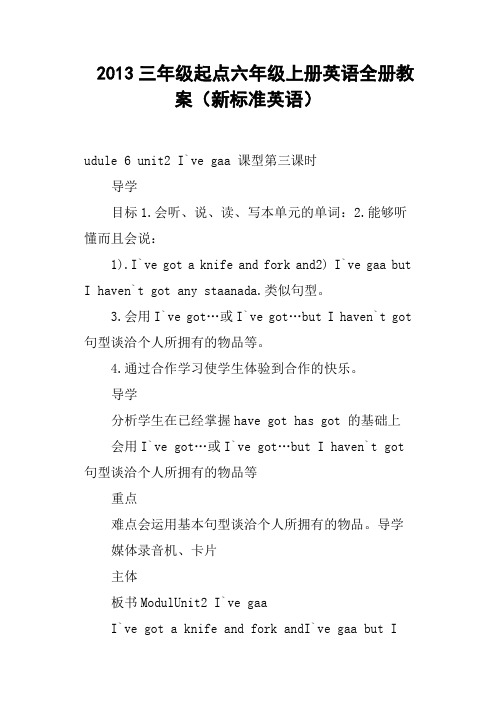
2013三年级起点六年级上册英语全册教案(新标准英语)udule 6 unit2 I`ve gaa 课型第三课时导学目标1.会听、说、读、写本单元的单词:2.能够听懂而且会说:1).I`ve got a knife and fork and2) I`ve gaa butI haven`t got any staanada.类似句型。
3.会用I`ve got…或I`ve got…but I haven`t got 句型谈洽个人所拥有的物品等。
4.通过合作学习使学生体验到合作的快乐。
导学分析学生在已经掌握have got has got 的基础上会用I`ve got…或I`ve got…but I haven`t got 句型谈洽个人所拥有的物品等重点难点会运用基本句型谈洽个人所拥有的物品。
导学媒体录音机、卡片主体板书ModulUnit2 I`ve gaaI`ve got a knife and fork andI`ve gaa but Ihaven`t got any staanada.导案学案二次修注一、warmming u: Modules 5中的歌曲“I can speak English.”Step2: GreetingsT: Wduty today ?二、呈现课文中句型::完成SB的活动5Game: Tabl)出示活动5的挂图2)让学生Look and sa师先示范:For example,“I`ve got a TV.”2再示范“I haven`t got a football.”3)师叫3位同学上台和老师合作说出图中的例句1.师先说I`ve got a TV再引导第1位同学说I`ve gota TV too And I `ve got a football再引导第2位学生说I haven`t got a football but I`ve got a basketball再引导第3位学生说I haven`t got abasketball but I`ve got a piano.4)引导小组合作学习5)叫一组男生,一组女生上台进行sa的比赛Step2:呈现SB活动2的句型1)Teacher手拿小刀、叉子、筷子说:Look , I`ve got a knife and fork and利用实物教学单词2)1.Teacher将手中的小刀、叉子、筷子递到一位同学手里,发问:Have you got a knife and?2.随机讲解or的用法。
【推荐】冀教版(三年级起点)英语六年级上册教案(全册)

上察隅镇中心小学六年级英语课时教学设计Lesson 1 At the Airport一、教学目标(一)知识目标1.学生能听懂会读本课课文。
2.使学生通过练习复习句子:What time is it? It’s ____.复习所学过的时间表达法。
(二)能力目标1.学生能够模仿课文对话,能练习相互问候的日常用语。
2.培养以旧带新掌握一定的语言技巧的能力,练习该如何表达时间。
(三)情感目标以情感培养人,培养学生珍惜时间的好习惯。
二、教学重点掌握what time is it ? It’s_三、教学难点学生能够准确的用英语表达时间。
四、教学用具录音机,磁带五、教学资源2 : 10 two ten or ewo past ten.4 : 30 four thirty or half past four.9 : 00 nine o’clock or nine.5 : 45 five forty-five or a quarter to six.六、教学过程:Step 1 : Review1) Play a game: “ The number game” to review number , play with numbers up to ten thousand .2) Review some phrases :What day is it ? What time is it ?Step 2 : Presentation and practice1.引出新课题,教授新单词airport,教读数遍并让学生明白单词的意思。
2.Ask and answer:1).Who is this?JennyDannyLi Ming.2).Where does Jenny live? Canada.Where does Li Ming live? China.3)How long is it from September 1 to June 25?Ss count the months:October November DecemberJanuary February…June.Wow!That’sten months.3.Teaching “ What time is it ? ”1) 指着自己的手腕处,T: What time is it ? (强调连读is it)S:“It’s ______”Explain that we use “o’clock” only on the hour.2) Demonstrate :T draws a clock on the blackboard.More the hands on the clock as T asks and answer the question . Then get volunteers to answer the question .Eg:2:40 two forty5:10 five ten6:37 six thirty seven9:00 nine o’clock3.Practice :1) Practice in pairs .2)Ask the volunteers to more the hands on the clock as they ask and answer the question .4.Teaching “ the text ”1)When the students listen to the tape , think over the question :a.Why does LiMing come to Canada (He wants to learn English)b.When does Li Ming arrive ?c.What time did Li Ming’s plane arrive ?d.Who meets him at the airport ?e.Did he have a good trip ?2)Read the dialogue and discuss the questions in groups .3)Ask the students to answer the questions .4)Read by themselves , then read role-play .Step 3.HomeworkMake up a dialogue about meeting someone at the airport . Use“ What time is it ? It’s .”七、BlackboardLesson 1 At the Airport5 o’clock——What time is it?6 o’clock——It’s5:25.Lesson2 Jenny’s House一、教学目标:(一)知识目标:1、能听、说、读、写单词:room; kitchen; bathroom; living room2、能用英语简单描述自己的家中的各个房间。
六年级英语上册教案(三年级起点新标准英语)

六年级英语上册教案(三年级起点新标准英语)odule1Unit1TheGreatall学习任务:Thesepostcardsaregreat!It’sapictureoftheGreatall功能:讲述关于某个地方或某件事物的情况。
运用任务:.热身复习老师热情地问候学生们,欢迎他们在暑假过后回到学校。
老师可以询问学生们在假期里都去了哪些地方,做了哪些事情,有没有特别有趣的经历。
建议他们通过展示图片和照片介绍相关的情况,可以使用句型“It’sapictureof.__It'svery…”等。
活动一:学习新词,并用新词造句。
帮助学生了解新词的含义,及实际运用。
.导入:老师从学生的图片或照片中选取几张比较典型的并提问:“Doyounothisplace?"引导全班学生自由回答,例如:T:Doyounothisplace?Ss:yes.It’s…T:canyoutellesoethingaboutit?Ss:yes,It's…T:canyoutelleoreaboutit?Ss:...问答完毕后,老师可以总结说:“Thesephotos/picturesaregreat!”老师再拿出一张来自纽约的明信片,复习单词“postcard"。
老师问:“Doyounothisplace?”学生应该能够回答:“yes,it’sNeyor.”老师引导学生说出:“It’sapictureofNeyor.”告诉学生,在这个暑假里,Daing去了美国旅游,并在那里经历了很多有趣的事情。
刚到表哥Sion家,行李还没有收拾好,Daing和Sion就迫不及待地聊开了。
请学生们注意他们使用的语言。
勾出学过的新词。
.课文教学将本课的挂图贴在黑板上,播放录音或动画,呈现SB 活动1。
请学生看图或动画,听听Daing和Sion的对话。
听完以后,请学生说一说:Sion是谁?Daing在哪里?两人在做什么?请学生翻开书,老师放录音,学生边听边看书,可以全班齐读,或分男生、女生或小组读。
新标准小学英语三年级起点第六册全册教案
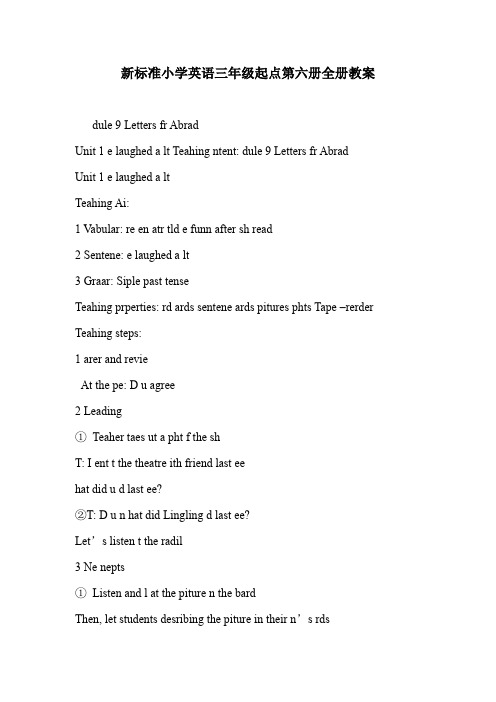
新标准小学英语三年级起点第六册全册教案dule 9 Letters fr AbradUnit 1 e laughed a lt Teahing ntent: dule 9 Letters fr Abrad Unit 1 e laughed a ltTeahing Ai:1 Vabular: re en atr tld e funn after sh read2 Sentene: e laughed a lt3 Graar: Siple past tenseTeahing prperties: rd ards sentene ards pitures phts Tape –rerder Teahing steps:1 arer and revieAt the pe: D u agree2 Leading①Teaher taes ut a pht f the shT: I ent t the theatre ith friend last eehat did u d last ee?②T: D u n hat did Lingling d last ee?Let’s listen t the radil3 Ne nepts①Listen and l at the piture n the bardThen, let students desribing the piture in their n’s rds②Sti the sentene ards n the bard, listen again Sentenes: e ent t a hildren’s theatreThe en re en’s lthesThe en re en’s lthesThe atrs tld lts f esIt as ver funne laughed a lte ent t a restau rant after the she all ate haburgers and hipsThen, let students desribing, use the sentene ards ③Teaher irles the rds: ent re tld as laughed ate Then, give the rds: g ear tell is laugh eatLet the students ath then④Read sentenes n the ardsLet students rellet hat did Lingling d last ee⑤Listen and repeat the text⑥Anser the questins n ur paperA here did Lingling g last ee?B hat did the en and the en ear?hat did the atrs d?D here did the g after the sh?E heat did the eat?4 PratieStudents tae ut their n pitures t desribing hat did the dD Ativit B①Exerise 1 Listen and plete the text②Exerise 4 Read and irle the rret rds6 HerTal abut hat u did esterda Designs: udule 9 Letters fr Abard Unit 1 e laughed a ltent laughere eattld isas glaughed areate tell 新标准英语三年级起点第六册教案dule 9 Letters fr AbradUnit 2 See u snTeahing Ai:1 Target language: Siple future tense ‘be ging t ‘2 Vabular: sn bed r histr questin brr evening3 Sentenes: e are ging t see u in three eesu bught ne hpstis fr uHe’s eating an apple n4Prnuniatin: ‘qu’‘sh’‘th’Sng: Pstan PstanTeahing prperties: rd ards sentene ards pitures tape-rerderTeahing steps:arer and revie1 Revise siple past tense ith these rdsre en atr tld e funn after sh read2 Sa a tngue tisterLeadingT: friend ill visit e sn I bught a bed and a bie fr hi N, let’s see hat did Sin’s parents bu fr DaingNe nepts1 Sti the piture n the bardPla the tape: L and listenThen, tal abut the letter in hinese2 Pla the tape again, listen and repeat3 Read the letter b urself4 Sti the sentene ards n the bardRevise siple past tense and siple future tensee are gng t see u in three eesDad is ging t put anther bed in ru bught ne hpstis fr uHe is ging t as u se questinse brred a bie fr uHare the students sti the pitures f Sin’s fail beside rret senteneAtivit 2 f SBFr an exaple ith the first pitureThen have the students desribe the ther pitures pa attentin t ‘siple past tense’and ‘siple future tense’6 Ativit 3 f SB①Listen and repeat pa attentin t the prnuniatin②Underline the letters that ae the sund7 Let’s sing①G thrugh the rds f the sng②Listen the tape, learn t sing③Sing the sng all tgetherPraties:1 Listen and sa, thenread the letter2 Exerise B①Read the ansers, then rite the questins②Gae: Sa and guessHer:1 p ne rds2 rite a letter Use the rds in the bxdule 9 Lettets fr abradUnit 2 See u Snsn questinbed brrr eveninghistr 新标准英语三年级起点第六册教案dule 10 PreparatinsUnit 1 here are u ging t g? Teahing betives:1 rds: list airprt she tiet tthbrush2 Sentenes: here are u ging t g?hat are u ging t tae?hen are u ging t g?h’s ging t g ith u?3 Graar: Siple future tenseTeahing prperties:ards pitures tape-rerderTeahing predures:1 Free tal:T: hat are u ging t d next Sunda?S: (Anser)T: h’s ging t travel?T: hat are u ging t tae?S: (Anser)T: hen are u ging t g?S: (Anser)T: h’s ging t g ith u?S: (Anser)T: I hpe u have a gd tie2 Ne textT: Daing is ging t travel Let’s have a l hat he is ging t d⑴Read the text, then find ut the ne rds⑵Teaher rite the ne rds n the blabard⑶Learn the ne rds⑷Pla the gae ith the ne rds⑸Read the text again⑹Listen t the tape⑺Find t students read the text⑻Read the text then find the teaher’s questins①here is Daing ging t g?②hat is Daing ging t tae?③hen is Daing ging t the airprt?④h’s ging t the airprt?⑼Students anser3 Pratie:Have t students tal their trip Use these sentenes⑴here are u ging t g?⑵hat are u ging t tae?⑶hen are u ging t g?⑷h’s ging t g ith u?4 Her⑴rite rds n the exerise b⑵Tal ur trip t ur friendsDesigns:dule 10 PreparatinsUnit 1 here are u ging t g?rds: sentenes:list here are u ging t g?airprt hat are u ging t tae?she hen are u ging t g?tiet h’s ging t g?tthbrush h’s ging t g ith u? 新标准英语三年级起点第六册教案dule 10 PreparatinsUnit 2 I’in Ne r nTeahing ntent: dule 10 PreparatinsUnit 2 I’in Ne r nTeahing betives:1 rds: arrive taxi flat building ade again2 Sentenes:Granda ade hinese fd fr eI ant t tr Aerian fdI ill rite again sn3 Pratise t prnune ‘h’‘r’4 Learn the sng: It’s a big exiting rldTeahing prperties: ards tape-rerder pituresTeahing preduresarer:1 Sti the pitures f unit 1 n the bard Have the students e t the frnt and ie the text f unit 12 Sa a sentene in the present tense and get the students sa it in the past tenseExaples:T: Daing ges t Ne rSs: Daing ent t Ne rT: Granda eets DaingSs: Grada et DaingTeah the text:1 Raise the piture f the St atue f Libert and as: hat is it ? here is it?”Guide the students sa: It’s the statue f Libert It’s in Ne r”T: Daing is in Ne r n Let’s see h et hi at the airprt hat he sa in Ne r and hat fd he anted t eat2 Pla the tape Have the students listen and underline the ne rds in bs3 Teah the ne rds4 Pla the tape again Have the students listen and sa After this, get the students t anser the flling questins:⑴h et Daing at the airprt? (Granda and Sin)⑵hat did Daing see in Ne r? (Buildings, ards and peple)⑶hat fd did he ant t tr? (Aerian fd)plete ativit 2 in SB (Get the students t as and anser in pairs)6 Pratise t prnune ‘h’ ‘r’7 Learn the sng: It’s a big exiting rld8 plete exerise 1 in ABHer:Pratise the flling sentenes in pairs:here are u fr?here are u ging t g?here are u ging t g there?here are u ging t d there?Designs:dule 10 PreparatinsUnit 2 I’in Ne r narrive Granda ad hinese fd fr e taxiflat I ant t tr Aerian fd buildingade I ill rite again snagain。
外研版六年级英语上册教案(三年级起点)
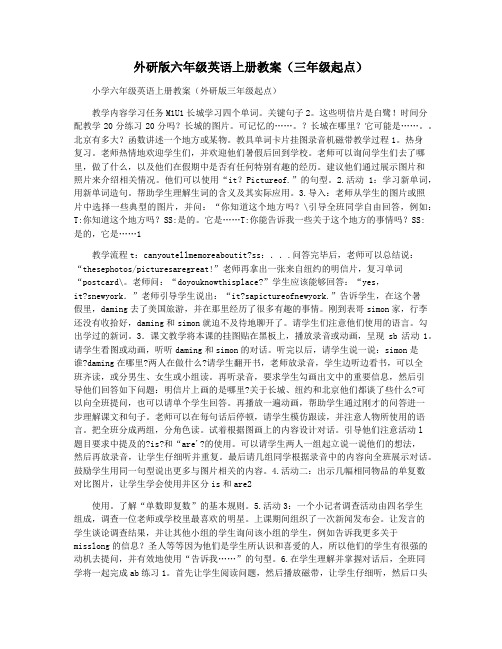
外研版六年级英语上册教案(三年级起点)小学六年级英语上册教案(外研版三年级起点)教学内容学习任务M1U1长城学习四个单词。
关键句子2。
这些明信片是白鹭!时间分配教学20分练习20分吗?长城的图片。
可记忆的……。
?长城在哪里?它可能是……。
北京有多大?函数讲述一个地方或某物。
教具单词卡片挂图录音机磁带教学过程1。
热身复习。
老师热情地欢迎学生们,并欢迎他们暑假后回到学校。
老师可以询问学生们去了哪里,做了什么,以及他们在假期中是否有任何特别有趣的经历。
建议他们通过展示图片和照片来介绍相关情况。
他们可以使用“it?Pictureof.”的句型。
2.活动1:学习新单词,用新单词造句。
帮助学生理解生词的含义及其实际应用。
3.导入:老师从学生的图片或照片中选择一些典型的图片,并问:“你知道这个地方吗?\引导全班同学自由回答,例如:T:你知道这个地方吗?SS:是的。
它是……T:你能告诉我一些关于这个地方的事情吗?SS:是的,它是 (1)教学流程t:canyoutellmemoreaboutit?ss:...问答完毕后,老师可以总结说:“thesephotos/picturesaregreat!”老师再拿出一张来自纽约的明信片,复习单词“postcard\。
老师问:“doyouknowthisplace?”学生应该能够回答:“yes,it?snewyork.”老师引导学生说出:“it?sapictureofnewyork.”告诉学生,在这个暑假里,daming去了美国旅游,并在那里经历了很多有趣的事情。
刚到表哥simon家,行李还没有收拾好,daming和simon就迫不及待地聊开了。
请学生们注意他们使用的语言。
勾出学过的新词。
3.课文教学将本课的挂图贴在黑板上,播放录音或动画,呈现sb活动1。
请学生看图或动画,听听daming和simon的对话。
听完以后,请学生说一说:simon是谁?daming在哪里?两人在做什么?请学生翻开书,老师放录音,学生边听边看书,可以全班齐读,或分男生、女生或小组读。
人教版(三年级起点版)六年级上册英语全套教案
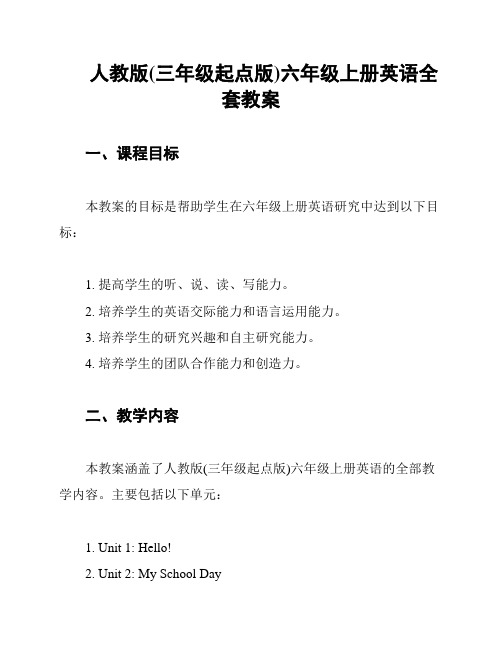
人教版(三年级起点版)六年级上册英语全套教案一、课程目标本教案的目标是帮助学生在六年级上册英语研究中达到以下目标:1. 提高学生的听、说、读、写能力。
2. 培养学生的英语交际能力和语言运用能力。
3. 培养学生的研究兴趣和自主研究能力。
4. 培养学生的团队合作能力和创造力。
二、教学内容本教案涵盖了人教版(三年级起点版)六年级上册英语的全部教学内容。
主要包括以下单元:1. Unit 1: Hello!2. Unit 2: My School Day3. Unit 3: My Family4. Unit 4: Sports Day5. Unit 5: My Classroom6. Unit 6: My Birthday7. Unit 7: On a Farm8. Unit 8: The Weather9. Unit 9: My Vacation10. Unit 10: Going Shopping每个单元的教学内容都包含了词汇、语法、听力、口语、阅读和写作等方面的综合训练。
三、教学方法为达到教学目标,本教案采用了多种教学方法,如:1. 基于任务的教学方法:通过让学生完成特定任务来促进实际语言运用能力。
2. 合作研究:鼓励学生之间的合作和互动,促进彼此研究和协作。
3. 游戏化教学:利用游戏和竞赛的元素提高学生的研究积极性和兴趣。
4. 录音教学:通过听录音材料提高学生的听力理解能力。
四、教学评估与反馈本教案中包含了各个单元的教学评估和反馈方式。
教师可以通过口语表达、写作练、听力测试等方式对学生的研究情况进行评估,并及时给予反馈和指导。
五、教学资源本教案中列举了相关的教学资源,包括教材、课件、练册、录音材料等。
教师可以根据需要选择和使用这些资源来辅助教学。
六、教学安排本教案给出了每个单元的教学安排,包括每个教学环节的时间分配和具体内容。
教师可根据具体情况进行调整,确保教学过程的有效性和高效性。
七、教学反思本教案中包含了教学反思的内容,教师可以根据实际教学情况对教学过程进行反思和总结,以不断优化自己的教学方法和策略。
六年级英语上册教案(三年级起点新标准英语).doc
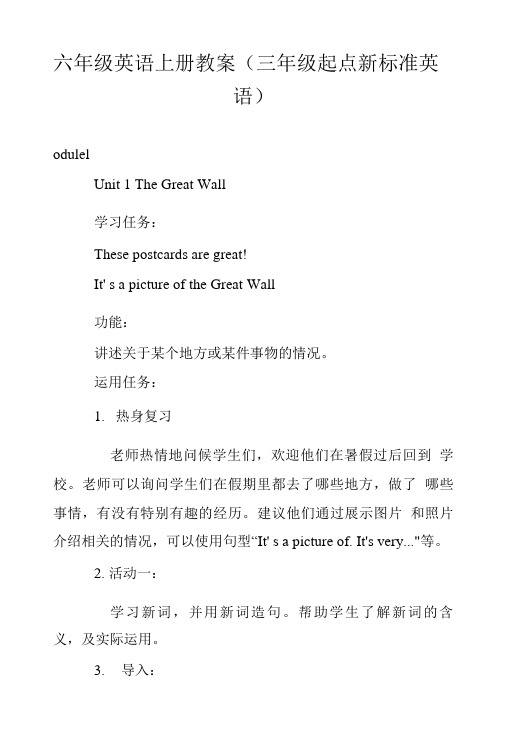
六年级英语上册教案(三年级起点新标准英语)odulelUnit 1 The Great Wall学习任务:These postcards are great!It' s a picture of the Great Wall功能:讲述关于某个地方或某件事物的情况。
运用任务:1.热身复习老师热情地问候学生们,欢迎他们在暑假过后回到学校。
老师可以询问学生们在假期里都去了哪些地方,做了哪些事情,有没有特别有趣的经历。
建议他们通过展示图片和照片介绍相关的情况,可以使用句型“It' s a p icture of. It's very..."等。
2.活动一:学习新词,并用新词造句。
帮助学生了解新词的含义,及实际运用。
3.导入:老师从学生的图片或照片中选取几张比较典型的并提问:"Do you know this place?”引导全班学生自由回答,例如:T: Do you know this place?Ss: Yes. It' s...T: Can you tell me something about it?Ss: Yes, It's...T: Can you tell me more about it?Ss:・..问答完毕后,老师可以总结说:"These photos/pictures are great!”老师再拿出一张来自纽约的明信片,复习单词"postcard”。
老师问:"Do you know this place?”学生应该能够回答:“Yes, it's New York. ”老师引导学生说出:Tt' s a picture of New York."告诉学生,在这个暑假里,Daming去了美国旅游,并在那里经历了很多有趣的事情。
刚到表哥Simon家,行李还没有收拾好,Daming和Simon就迫不及待地聊开了。
人教版(PEP三年级起点)小学英语六年级上册精品课件(全册)15035m

(三年级起点)
[精品]
人教(PEP)版六年级英语上册
(三年级起点)
Unit 1 How can I get there?
第一课时
课前热身
Let’s sing!
Twinkle twinkle little star
Twinkle, twinkle, little star. How I wonder what you are. Up above the world so high. Like a diamond in the sky. Twinkle, twinkle, little star. How I wonder what you are.
—(地点名词)在哪儿? —它紧挨着/附近/后面(地点名词)。
重难点探究
重点词汇1
science /ˈsaɪəns / (名词)科学
短语 例句 延伸
the science book科学书
Science is very interesting. 科学非常的有趣。
scientific 科学的
重难点探究
poster 海报 office 办公室 officer 公务员
重难点探究
重点词汇4
bookstore /'bʊkstɔː/ (名词)书店
复数形式 bookstores
例句 Where is the bookstore? 书店在哪儿?
重难点探究
重点词汇5
cinema /ˈsɪnəmə / (名词)电影院
注意:
Turn right at the hospital .
到医院右拐。 除了学习一些问路的话语,还要学习一些指 路的语言。
外研社(三起)六年级上册英语Module 1 Unit 2 It’s in the west教案
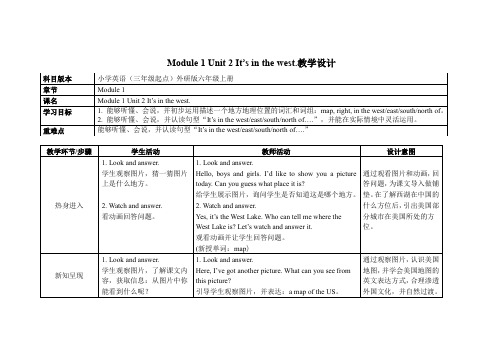
2. Role play.
准备并表演已经编好的对话。
1. Talk about these things.
Now let’s talk about the picture.
教师组织学生观察图片、合作并创编对话。
2. Role play.
Ask students to make role plays.
通过观看图片和动画,回答问题,为课文导入做铺垫。在了解西湖在中国的什么方位后,引出美国部分城市在美国所处的方位。
新知呈现
1. Look and answer.
学生观察图片,了解课文内容,获取信息:从图片中你能看到什么呢?
2. Watch and answer.
Watch the video and answer the question.
Here, I’ve got another picture. What can you see from this picture?
引导学生观察图片,并表达:a map of the US。
2.Watch and answer.
Ask Students to watch the second video and get to know how many cities there are in the video.
播放关于美国城市的动画,让学生回答在动画中出现了几个美国城市?
3. Listen and answer.
Ask Students to listen to the recording, and answer the detailed questions.
引导学生听录音,了解课文细节内容,并回答问题。
给学生展示图片,询问学生是否知道这是哪个地方。
北师大版小学六年级英语上册(三年级起点)全册教案

Unit1 Space新课标体现:本单元主要是要求学生能够用过去时表达过去发生的一些事情,能够用本单元主要句式询问对方或他人在过去时间的住所。
让学生对一般过去时有一个初步的认识。
引导学生形成与人为善的态度。
本单元能够丰富学生的天文知识,激发学生乐于观察的热情。
Teaching Aims:知识技能:1、Listening:能够理解本单元的故事。
2、Speaking:能用过去时简单的描述在过去发生的事情,能用本单元主要句式询问对方或他人在过去时间的住所。
3、Reading:能正确、流利的朗读课文和一些辅音的读法。
4、Writing:能正确、规范地拼写本单元要求掌握的生词和短语;能听写本单元功能句,并做出应答。
过程方法:1、利用现有的教设备资源,使学生可以更加直观的对所要学习的内容有整体了解,并且可以培养学生良好的发音习惯,为以后的学习打下基础。
2、在教授对话的同时,把单词或重点句型出示给学生,这样可以使学生更方便于学习,掌握,和运用。
3、在教学时多采取同学之间互相帮助的功能,可以加深同学之间的感情,还可以帮助班主任更好的完成思想道德教育工作。
Teaching Emphasis:1.Where are you from? 及回答.2.Where were you yesterday afternoon? I was at home.3.过去时was, were, had 的表达Teaching Difficulty:1.过去时的用法及表达。
2.如何用过去时描述自己的梦和过去所在的场所。
3.一些单词的记忆。
Lesson1Teaching Aims:1. The students can describe the picture.2. The students like to learn English.3. The students can be writing and reading.Teaching Emphasis:1. How can use “had, was, were” in dialogue. Answer it.Teaching Difficulty1. How to use past tense.2. Emphasis new words.Teaching process:Step1:T: Introduce myself and let student introduce themselves (name, age, hobby and so on) S: Introduce themselves about name, age etc.Step2:To review what has been learned last semester.Step3:Set the sceneT: Let the children talk about what they did during the summer vacation. Ask some questions: Where you went? Who you saw? What you did?Let them share their experience with each other.S: Try to answer the questions.T: Ask the children the question, “Where were you?”S: Try to answer the question.Step4:Get preparedT: Ask children if they had any dream at night these days. Let them talk about their dreams.S: Try to talk about their dreamsT: let them read about Ann’s dream.S: Read Ann’s dream.T: To describe what illustrated in each picture and the main plot is.S: Listen and think.T: Play the tape for the story.S: Listen to the tape.Step5:Tell the storyT: Have the children look at the pictures .The teacher tells the story to the children.S: Listen and look at the picture.T: Have the children read the text by themselves.S: Read the text.T: Listen to the tape. Play the tape again. Ask some questions.Who had a dream?Who were in her dream?Where were they?Where were they now?Was it cold on Mars?Were there Martians on Mars? How do you think Ken and Ann fell?Were the Martians friendly?S: Try to answer the questions.Step6:Homework: Have the children create their own image of Martians.Blackboard writing:Ann had a dream last night.She and Ken were in her dream.They were in the space.They were on Mars.It was very cold on Mars.There were Martians on Mars. Ken and Ann were afraid.Yes, the Martians were friendly.课后反思:Lesson 2Teaching Aims:1. The students can describe the picture.2. The students like to learn English.3. The students can be writing and reading.Teaching Emphasis:1. How can use “had, was, were” in dialogue. Answer it.Teaching Difficulty1. How to use past tense.2. Emphasis new words.Teaching process:Step1:Review :( plays a game)T: Take a card and hide it. I had a dream last night. In my dream I was…S: Guess it.Step2:Learn the new words.T: Have the children open their books at page4. Draw their attention to the top half of the page. Point to the picture and ask: “What can you see in the picture?”S: Open the book and answer the question.T: Model the word and have the children repeat. Use the same procedure with the other words in the picture.S: Read the words after the teacher.T: Let student read the words again.S: read the words.T: Let students listen to the tape and point the new wordsS: listen and point. Repeat after the tape.Step3:Listen and number.T: Have the children look at the pictures at the bottom of the page. Explain that each of the pictures describes a different dream of Ann.S: Look at the picture.T: Let the children talk about where Ann was and what she was in each dream.S: Answer it.T: Play the tape. Let the children point the picture.S: Listen to the tape and point the picture.T: Play the tape again. Let children write the corresponding sentence number in the box next to the matching picture.S: listen and match.T: Point to each picture and elicit sentences from the children.Step4:Talk togetherT: Have the children open the books at page 5 and look at the picture on top of the page. S: Open the books look at the picture.T: Explain that Sue and Peter are talking about where they were yesterday. Ask the children where they think Sue and Peter were yesterday.S: Answer the question.T: Read the text and ask the children repeat.S: Listen and repeat.T: Pair works. For example, where was Ann yesterday? She was at the swimming pool. S: Practice the dialog.Step5:Listen and practice.T: Draw their attention to the picture at the bottom of the page. Have them talk about the picture and then practice reading the sentence by them.S: Talk about the picture.T: Play the tape and let student read after the tape.S: Listen and read.Step6:Homework: Read the story.Blackboard writing:Dream, Last night, air, afraid, yesterday, were, was, had, space, a spaceship, a space suit, an astronaut, a planet, the moon, stars.教学反思:Lesson3Teaching Aims:1. The students can tell the story.2. The students like to learn English.3. The students can be writing and speaking.Teaching Emphasis:1. How can use “had, was, were” to make sentences.Teaching Difficulty1. How to use past tense.2. How to tell the story..Teaching process:Step1:Review the story.T: Point to each picture, elicit the story from the children. Point to the first picture and say, “In this picture, Ann had a…” Elicit from the children Ann had a dream. Repeat with other pictures and highlight the sentences They were on Mars. They were in a spaceship. S: Follow the teacher and retell the story.T: Ask the questions, “Where were you yesterday?”S: I was at school. I was at home. I had an English class etc.T: write the sentences on the blackboard and let the children read each sentences.S: Read the sentences after the teacher.Step2:Uncle Booky’s BlackboardT: Tell the children to look at the blackboard on the top of page 6. Model the structures by reading them aloud to the class.S: Listen and think.T: Have the children repeat the structures in a class drill. Use all possible combinations. S: Repeat the structures.T: Explain that we use was/were to describe things that happened in the past. Give an example, He was in Shanghai yesterday. He is in Beijing now.S: Make the sentences by themselves.Step3:Touch and say.T: Let the children look at the pictures at the bottom of the page. Let them tell the Mocky’s dream and that they only to say one sentence for each picture.S: Try to tell the dream.T: Ask some questions, “Who were in Mocky’s dream? Where were they?S: Try to answer the questions.T: Point to the picture and elicit descriptions from the children.S: Try to describe the pictures.Step4:Read and write.T: Have the children open the books at page 7. Explain to the children that the letter was written by a girl called Jane. Have them complete the letter.S: Try to complete the letter.T: If the children cannot do it, discuss with your partner.S: Do it and discuss.T: Let the children read the letter together.S: Read the letter.T: Have the children write about Uncle Booky’s dream.S: Try to write it by them.Step5:Tell the dream.T: Have the children to tell each other their dreams like two children on the book. Put them into pairs and practice.S: Try to tell the dream about them.Step6:Homework: Tell the dream to their parents.Blackboard writing:I was at home. We were at home.I was at school. We were at school.I had an English class. We had an English class.课后反思:Lesson4Teaching Aims:1. The students can read the special sounds.2. The students like to learn English.3. The students can be listening and match.Teaching Emphasis:1. How to pronounce the special soundsTeaching Difficulty1. How to pronounce the special sounds.2. Listening and match and interview the students..Teaching process:Step1:Special sounds.T: Have the children look at the pictures and try to read the words.S: Look at the picture and try to read.T: Play the tape and have the children repeat.S: Listen and repeat.Step2:Decode the messageT: Have the children open the book and ask them if they can read the message.S: Look at the message.T: Have the children look at the code and ask the children to decipher the message by themselves.S: Decipher the message.Step3:Write the messageT: Have the children write the message to the Martians.S: Write the message.T: Have the children pair work (They give their message to each other and decode the message)S: Decode the message.Step4:Listen and match.T: Have the children look at the pictures on top of page9.S: Open the books.T: Have the children talk about the pictures.S: Talk about the pictures.T: Play the tape and have the children listen and match.S: Listen to the tape and match.T: Have the children tell the teacher the name of the children was in the pictures.Step5:Ask and find out.T: Have the children look at the pictures at the bottom of the page.S: Look at the picturesT: Have the children interview the other students for where they were yesterday.S: Interview and write the sentences on the book.When they finished have them report their findings.Homework:Write the message to the Martians.教学反思:Lesson5Teaching Aims:1. The students can read the story.2. The students like to learn English.3. The students can be listening and match.Teaching Emphasis:1. How to read the story and choose the right answerTeaching Difficulty1. How to read the story.2. How to answer the questions and write the wordsTeaching process:Step1:Read the story.T: Have the children open their books at page 10 and explain the new words.S: Read the new words.T: Have the children read the story by themselves.S: Read the story.T: Ask some questions about the story.S: Answer the questionsT: Play the tape and have the children listen carefully.S: Listen to the tape.Step2:Number the picture.T: Have the children look at the pictures and read the story again and number the pictures. S: Read the story and number.T: Have the children point to the pictures and find the sentences in the story.S: Point and find.T: Have the children read the story again and number the pictures.S: Read the story and number.Step3:Check the correct answer.T: Have the children read the story and find the correct answer.S: Read the story and do it.T: Have the children pair work.S: Pair work.Step4:Listen and write the words.T: Explain the words.S: Look at the form.T: Play the tape and have the children complete the story.S: Listen to the tape and do exercise.T: Correct the answer.Homework:Tell the story to the parents.教学反思:Lesson6Teaching Aims:1. The students can read the story.2. The students like to learn English.3. The students can be listening and match.Teaching Emphasis:1. How to read the story and choose the right answerTeaching Difficulty1. How to read the story.2. How to answer the questions and write the wordsTeaching process:Step1:Review the Ann’s dreamT: Have the children try to retell the Ann’s dream.S: Try to retell.T: Have the children retell the dream together.S: Do it.Step2:T: Have the children try to read Lane’s dream, and try to write the missing words. S: Read the Lane’s dream and tr y to write the missing words.T: Have the children try to read the dream and check the answer.S: Check the answer.Step3:T: Have the children write the Uncle Booky’s dream.S: Try to write it.T: Review Ann’s dream with children.S: Retell the dream.T: Have the children write three sentences about Ann’s dream.S: Try to do it.Step4:ReflectionT: Explain some sentences to the children.S: Open the books and look at the sentences.T: Have the children read the sentences and try to do it.S: Read the sentences and write the answer about this unit.T: Have the children do the group work.S: Group work and finish the reflection.Homework:Review Ann’s dream.Homework: Have the children write Ann’s dream.教学反思:Unit2 An Accident新课标体现:本单元主要是要求学生能够用过去时表达过去发生的一些事情,能够用本单元主要句式询问对方或他人在过去时间在干什么。
外研社六年级英语上册教案(三年级起点)

教案说明:本教案汇集了全国多位优秀教师的心血,凝聚了大家的智慧,教案严格按照高效课堂要求编写,环节齐全内容详细,可以直接用A4纸打印,本教案形式多样,为大家提供更广阔的视野,当然,也还有诸多不足之处,望大家多提建议和意见。
任教学科:____________________任课班级:____________________任课班级:____________________Module1 Unit1 It’s more than twenty thousand kilometers long.Teaching aims:1.单词:more than,thousand,kilometre,million,something,map, right, country2.学习句子:These postcards are great!How long is it? It’s more than twenty thousand kilometers long.How big is New York? It has got more than eight million people. Teaching importance:1.能口头运用这类语句说明How long is it?It’s more than twenty thousand kilometers long.2.运用Where is New York?Teaching difficulties:1.能口头运用这类语句How long is it?It’s more than twenty thousand kilometers long.说明历史古迹。
运用Where is New York?It’s here in the east.Teaching aids:tape-recorder, word cards, PPT, multi-media computer.Preset demands:1 Review the past tense.2 Listen to the tape and circle the words that you don’t under stand. Teaching preset procedures:Unit1 It’s more than twenty thousand kilometers long.1: Warm up1) Greetings.2) Sing a song: Row a boat.3)Free talk: Describe their summer holiday. “Life is like a dream.””My summer holiday is like a dream, (课件出示)I read books in the library…What did you do in summer holiday?”Free talk.2 Presentation1) Show the Task: 描述某一地点,如北京,上海,宁夏等。
2017-2018学年人教版PEP2013新版小学六年级英语上册全册全套精品教案
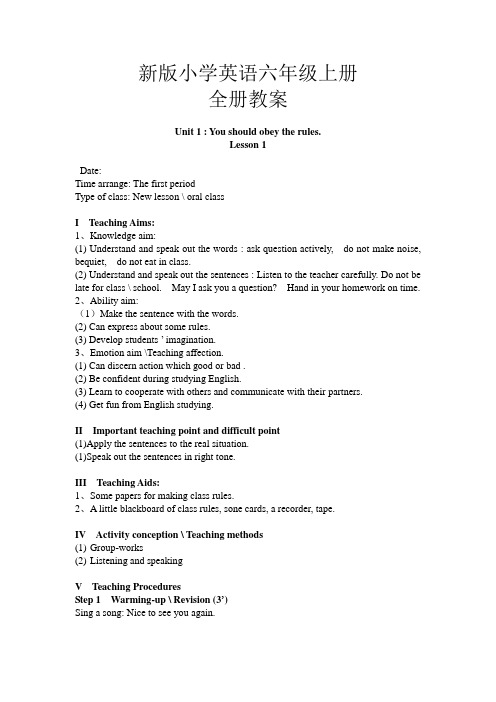
新版小学英语六年级上册全册教案Unit 1 : You should obey the rules.Lesson 1Date:Time arrange: The first periodType of class: New lesson \ oral classI Teaching Aims:1、Knowledge aim:(1) Understand and speak out the words : ask question actively, do not make noise, bequiet, do not eat in class.(2) Understand and speak out the sentences : Listen to the teacher carefully. Do not be late for class \ school. May I ask you a question? Hand in your homework on time.2、Ability aim:(1)Make the sentence with the words.(2) Can express about some rules.(3) Develop students ’ imagination.3、Emotion aim \Teaching affection.(1) Can discern action which good or bad .(2) Be confident during studying English.(3) Learn to cooperate with others and communicate with their partners.(4) Get fun from English studying.II Important teaching point and difficult point(1)Apply the sentences to the real situation.(1)Speak out the sentences in right tone.III Teaching Aids:1、Some papers for making class rules.2、A little blackboard of class rules, sone cards, a recorder, tape.IV Activity conception \ Teaching methods(1)Group-works(2)Listening and speakingV Teaching ProceduresStep 1 Warming-up \ Revision (3’)Sing a song: Nice to see you again.Step 2 Presentation (12’)(1)T: Hi ! Boys and girls, How is your holiday ?(2)Ss:------(3)T:New semester is begin, how are you going to study in the new semester?(4)Ss:------(5)Please, have a look, How is Gao Wei going to do in the new semester.(6)Ss : Open the book and observe the picture..(7)Listen to the tape and answer some questions.(8)T : may I ask you a question? How student is Gao Wei?(9)Ss : Gao Wei is good student.(10)T: Why to say that?(11)Ss: He comes to school early. He listen to his teacher carefully. He is a groupleader.(12)T :Yes, he knows everyone in school should obey the rules. T:Write the blackboard design: Unit1 You should obey the rules.(13)Ss :Read the topic.(14)T : How about you, boys and girls ?(15)Ss :------(16)T: Gao Wei’s group is making a list of rules for the class. What rules do youknow? Let’s read the class rules. (Show the class rules with little blackboard) (17)T: Teach the sentences and words with some actions.Step 3 Practice (20’)(1)T : May I ask you some questions ? Who’s your group leader ? Is he \she fit forthis task ? Why do you say that ?(2)Ss:------(3)Make our class rules in your group, please.Step 4 Assessment (5’)(1)Report the class rules.(2)Read the class rules.(3)T: Let’s obey the class rules. You should obey the rules.VI HomeworkRead the class rules to your group leader .VI The blackboard designUnit 1 You should obey the rules. Lesson 1Listen to teacher carefully.Hand in you homework on time. Don’t be late for class.Don’t make noise in class.VII Back courtingLesson2Date:Time arrange: The second periodType of class: Practice lessonI Teaching Aims1、Knowledge aim:(1) Can act with sentences.(2)Can advise others how to obey the class rules.(3) Can correctly write the words and sentences .(4) Can read and chant : Let’s read and chant2、Ability aim :(1) Develop the student’s imagination.(2)Can apply the sentences to the real situation.3、Teaching affection :(1) Foster the Ss have a good habit.(2)Improve the Ss’ discrimination.(3) To promote the Ss’ interest.II Important teaching point and diffeculte teaching point1、Can advise correct suggestion to others in the real situation.2、Pay attention to the Ss’ pronunciation and tones.III Teaching Aids :Some objects for action, recorder ,picture card.IV Teaching Methods(1)TPR happy teaching method(2)Listening and Speaking(3)Direct Method(4) Group workV Teaching ProceduresStep 1 Warm up \ Revision (5’)(1)Duty-reportAct out with the card.Step 2 Presentation (15’)Let’s talk(1)T: What’s he \ she doing ? She \He right or wrong ? (Show the card) Tellthem to obey the school rules,please.(2)Observe the picture of ―Let’s tall‖. Tell them how to obey theschool rules . Talk to your group.(3)Write the word and sentence.Step 3 Practice (10’)Let’s read and chant(1)Read to your partner.(2)Listen to the tape.(3)Chant together.Step 4 Assessment (10’)Write the words and sentences .VI HomeworkDictation the words and sentence.VII The blackboard designUnit 1 Lesson 2School rules :Don’t ------You should ------ VIII Back courtingLesson 3Date :Time arrange :The third periodType of class : New lessonI Teaching Aims1 Knowledge aim :(1) Understand and speak out the words: help to set the dinner table, go to bed early, keep your room clean, make a mess, should, shouldn’t.(2) Understand and speak out the sentences: You should help to set the dinner table. You should go to bed early. You should keep your room clean. You shouldn’t read in bed. You shouldn’t watch TV till late. You shouldn’t make a mess in your room.2 Ability aima :(1) Make sentences with the words .(2) Can advise correct suggestion to others .3 Teaching affection :(1) Be confident during studying English .(2) Learn to cooperate with others and communicate with their partners .(3) Get fun from English studying.II Teaching important and difficult points(1)Can speak out the sentences in right tone.(2)Apply the sentences to the real situation.III Teaching AidsPicture card, recorder-tape, stickers.IV Teaching Methods1 Situational teaching method2 Direct teaching method3 Listening and speaking4 TPR happy teaching methodV Teaching proceduresStep 1 Warming up \ Revision (5’)Have a race: Make sentences .Step 2 Presentation (15’)(1)Listen and discrimminate wich manner is good or bad.(2)Let’s have a look some picture of the lesson 3. Guess ,is Peter a goodstudent or good boy ?(3)Listen to the tape and answer the question.(4)Teach the words and sentences.(5)Do you want to talk with Peter ? Tell him how should to do.(6)Thing over it ,what does Peter’s mother write for him ?(7)Read the home rules.Step 3 Practice (15’)Talk about your home rules in your group.Step 4 Assessment (5’)Read the home rules to your group leader.VI HomeworkMake a home rule for yourself.VII The Blackboard designUnit 1 Lesson 3You should--------You shouldn’t------VIII Back courtingLesson 4Date:Time arrange: The fourth periodType of class: Consolidation lessonI Teaching Aims1 Knowledge aim:(1)Understand and speak out the words : keep your desk clean , make a mess , help to set the dinner table , go home too late .(2) Understand and speak out the sentences : You should go to bed early . You shouldn’t make a mess in your room .(3)Make alest of home rules put it in your living room .(4)Let’s read and chant .3、Ability aim:(1) Make sentences with words.(2)Make home rules fom yourself.(3) Develop the Ss ’imagination.3、Teaching affection(1)Be confident during English .(2) Learn to cooperate with others and communicate with their partners .(3) Get fun from English studying.II Important teaching point and difficult pointSpeak out the sentences in right tone and apply the sentences to the real situation .III Teaching Aidspicture card , recorder , stickers .IV Teaching Methods1 TPR teaching method2 Situational teaching method3 Direct teaching method4 Listening and speakingV Teaching ProceduresStep1 Warming-up \ Revision(1)Duty-reportTalk about you home rule .Step 2 Presentation(1)Apprase these manner right or bad each other .(2)Advise others how to make the home rule and obey the rules .(3)Write the sentences in your excisese bookStep 3 PracticeLet’s read and chantStep 4 AssessmentRead the words and sentences to your group leader.VI HomeworkWrite the sentences and dictation the words and the sentences . VII The blackboard designWe should ------We shouldn’t -------Lesson 5Date :Time arrange: The fifth periodType of class : Oral lessonI Teaching Aims1 Knowledge aim:(1) Understand and speak out the words: take good care of young children , keep off the grass , play on the street , spit on the ground , litter , wait , must .mustn’t.(2) Understand and speak out the sentences : Look out ! You must wait .You mustn’t pick the flowers . You mustn’t cross the road now . You must wait for the green light .2 Ability aim :(1) Can make sentences with the words .(2) Apply the sentences to the real situation .(3) Develop the Ss’ imagination .3 Teaching affection(1) To promote the Ss’ interest .(2) To foster the dialogue confidence .(3) Learn to cooperate with others and communicate with their partners .II Important teaching poit and difficult point(1)Can speak out the words and sentences in right tone .(2)Apply the sentences to the real situation .III Teaching Aidspicture cards , recorder , some objects .VI Teaching Methods1Situational teaching method2Direct teaching method3TPR teaching methodV Teaching proceduresStep 1 Warming-up \ Revision (3’) Let’s sing : Traffic lightStep 2 Presentation (17’)(1) T :Shows the picture cards : What’s he \ she doing ?That’s right or wrong ?Ss : You should ------You shouldn’t ------T : We must ------We mustn’t ------(3)Listen to the record and reapt(4)Read the dialogue in your group .Step 3 Practice (15’)Have a race : Act the dialogue .Step 4 Assessment (5’)Write the words and sentences .VI HomeworkRead the dialogue to your group leader .VII The Blackboard designUnit 1 Lesson5Look out !You must wait !You mustn’t ------ VIII Back courtingLesson 6Date :Time arrange : The sixth periodType of class : Practice lessonI Teaching Aims1 Knowledge aim(1) Act and speak out the words : respect old people and help them ,take good care of young children , keep off the grass , play on the street , spit on the ground , litter .(2)Can act the sentences : Look out ! You mustn’t cross the road now ! You must wait .(3) Can write and dictation the words and sentences .(4) Make a sign to tell people what they mustn’t \ must do .(5) Let’s read and chant2 Ability aimCan advise others how to obey the traffic rules and helps others .4Teaching affection(1)To foster the Ss’ cooperation .(2)To foster the dialogue confidence .(3)To foster the Ss’ interest .II Teaching important and difficult points(1)Apply the sentences to the real situation .(2)Pay attention to the Ss’ pronunciation .III Teaching AidSome objects , picture card , recorder .IV Teaching Methods1Direct Teaching Method2Situational Teaching Method3TPR happy Teaching MethodV Teaching proceduresStep 1 Warming-up \ revision (5’)(1)Listen and do(2)Sing the traffic song .Step 2 Presentation (15’)(1)Pick up some one and speak out traffic rules with their action .(2)Listen and act .(3)Read the pictures cards .(4)Make a traffic sign and talk in your group .(5)Write the words and sentences .Step 3 Practice (10’)Let’s read and chantStep 4 Assessment (10’)Write the words and sentences .VI HomeworkDictation the words and sentences to your group leader .VII The blackboard designUnit1 Lesson 6You must ------You mustn’t ------RevisionDate :Time arrange : The seventh perionType of lesson : Consolidation lessonI Teaching Aims1 Knowledge aim(1) Can read and understand the story .(2) Can speak out these rules to others .2 Ability aim(1) Can act the story to the real situation .(2) Can advise correctly suggestion to others .(3) Develop the Ss’ imagination .3 Teaching affection(1) To promote the Ss’ interest .(2) To foster the Ss’ cooperation .(3) To foster the dialogue confidence .II Teaching important and difficult points(1)Apply the sentences to the real situation .(2)Pay attention the Ss’ pronunciation .III Teaching AidsObject , recorder , picture card ,stickers ,headprops . IV Teaching Methods1Situational teaching method2Direct teaching method3TPR happy teaching method4 Listening and speakingV Teaching proceduresStep 1 Warming-up \ Revision (5’)Listen and doStep 2 Presentation (15’)(1)Look at the picture and listen to the tape . Then , try to answer thesequestions : who are they ? What are thy doing ? What sign is the dog holding up ? What sign is the panda holding up ? What sign is the rabbit holding up ? What sign is the Mimi holding up ? What sign is the Micky holding up ?(2)Read the story in your group .Step 3 Practice (15’)Act the story .Step 4 Assessment (5’)Make dialogu in your partners .VI HomeworkRead the story to your leader .VII The Blackboard designThe panda’sign : keep off the grass !The dog’ sign : no crossing !The rabbit’ sign : Be quiet !The cat’ sign : Look out !The Micky’ sign : No littering !VIII Back courtingUnit 2 I usually go to school by bus .Lesson 7Date :Time arrange : The first periodType of class : Oral lessonI Teaching Aims1 Knowledge aim(1) Understand and speak out the words : go to school , morning , at , AM .(2) Understand and speak out the sentences : I go to school at 7:00 in the morning .(3) Study e-mail’s format .(4) Can write the words and sentences .2 Ability aim(1) Can make sentences with the words .(2) Can apply the sentences to the real situation .3 Teaching affection(1) To promote the Ss’ cooperation .(2) To foster the Ss’ interest .(3) To foster the Ss’ confidence .(4) To foster the Ss’ good habit(5) To know the west ’ cultures .II Teaching important and difficult point .1Apply the sentences to the real situation .2Pay attention the Ss’ pronunciation and tones .III Teaching AidsCountry flags , recorder , picture card , stickers .IV Teaching Methods1Direct teaching method2Situational teaching method3Listening and speaking4TPR happy teaching methodV Teaching proceduresStep 1 Warming-up \ Revision (3’)(1)Sing a song : I want to be your friend .(2)GreetingStep 2 Presentation (17’)(1)T : Guess, where does they come from ?( Show the pictur.)(2)Listen and answer some questions : Where does Lucy come from ? What’sthe e-mail about ?(3)Talk about your daily life .(4)Read the e-mail .Step 3 Practice (10’)Talk about your daily life to partners .Step 4 Assessment (10’)Read the words and sentences to your group leader .VI HomeworkWrite the words and sentences .VII The Blackboard designLesson 7Lucy’ daily life :Get up : Go to school:Have classes : Go home :Watch TV : Go to bed : VIII Back courtingLesson 8Date:Time arrange :The second periodType of class : Practice lessonI Teaching Aims1 Knowledge aim(1) Understand and speak out the words : have breakfast ,have lunch , have dunner ,go to school , have classes , go home , watch TV , go to bed , 7:00 AM , 12:00 , 6 :00 PM .(2) Understand and speak out the sentences : I go to school at 7 :00 in the morning . I go to bed at 9 :oo in the evening .(3) Can dictation the words and the sentences .(4) Let’s make motes .(5) Let’s read and chant .2 Ability aim(1) Can introduce my daily life to others .(2) Can make notes .(3) Develop the Ss’ imagination .3 Teaching Affection(1) Have a nice habit .(2) To promote the Ss’ cooperation .(3) To foster the Ss’ confidence .II Teaching important and difficult point(1)Apply the sentences to the real situation .(2)Attention the Ss’ pronunciation and tones .(3)Can dictation the main words and sentence .III Teaching Aidspicture card , recorder , stickers , clock .IV Teaching Methods1 Direct Teaching Method2 Listening and SpeakingV Teaching ProceduresStep 1 Warming-up \ Revision (5’)Sing a song : I have --- in the ---Read the wordsStep 2 Practice (15’)(1)T: We usually go to school .What time do you usually go to school ?(Show the clock . )(2)Introduce your daily life .(3)Listen to the tape and repeat .Step 3 Practice (15’)Make the sentences with words .Make your daily life note in your group .Let’ read and chant .Step 4 Consolidation (5’)Write the main words and sentence .VI The homeworkDictation the master words and sentence to your group leader .VII The black board designUnit 2 Lesson 8I have breakfast at__________________I have lunch at _____________________I have dinner at __________________________I go to school at 7:00 in the morning VIII Back CourtingLesson 9Date :Time arrange :The third periodType of class : Oral lessonI Teaching Aims1 Knowledge aim(1) Understand and speak out the words : get up , get home , take a long walk ,water the flowers ,play with his pet dog ,best wishes .(2) Understand and speak out the text .2 Ability aim(1) Make the sentence with the words .(2) Can introduce about others’ daily life .(3) Affection aim(1) To promote the Ss’ conffidence and interest .(2) To teach the Ss have a good habit in daily life .II Teaching Important and Difficult point .(1)Can understand and speak out the text .(2)Can speak in right tones .III Teaching Aidsrecorder –tape , picture card , stickers .IV Teaching Methods1 Direct Teaching Method2 Listening and SpeakingV Teaching ProceduresStep 1 Warming-up \ Revision (5’)Duty—report :Let me tell you something about my family .Step 2 Presentation (15’)(1)T: You have a happy family . And whom do you love best I your family ?Why ?(2)Listen to the tape . Try to answer the questions : What is Lucy talking ?How does Lucy’ grandpa daily life ?(3)Read text together .(4)Teach the words .Step 3 Practice (10’)(1)Read the text one by one in you group .Step 4 Assessment (10’)(1)Have a race :Ask and answer some questions .VI HomeworkAnswer the questions :What tune does her grandpa get up ?What does he do from 6:15 to 7:00 ?What does he usually do in the afternoon ?Does he go out in the evening ?What time does he go to bes ?VII The blackboard DesignUnit 2 Lesson 9My grandpa’ daily lifeHe gets up at 6:00 every morning .He take a long walk from 6:15 to 7:00 in the morning .He reads the newspapers in the morning .He usually waters the flowers in his garden or plays with his pet dog in theafternoon .He don't go out in the evening .He goes to bed at about 9:30 in the evening . VII IBack CourtingLesson 10Date :Time arrange : The fruoth periodType of class : Practice lessonI Teaching Aims1 Knowledge aim(1) Understand and speak out the words : go to the cinema , play the piano ,stay up very late , gets home very late , go shopping ,in the evening ,doesn’t , don’t , go out , get up .(2) understand and speak out the sentences : I get up at 7:00 in the morning .He gets up at 6:00 in the morning .(3) Talk about others daily life .(4) Let’s read and chant .2 Ability aim(1) Can make sentences with the words .(2) Can introduce others daily lefe .3 Affection aim(1) To promote the Ss’ interest and cofidence .(2) To foster the Ss’ cooperation .(3) To foster the Ss’ good habit .II Teaching Important and Difficult point(1)Apply the sentences to the real situation .(2)Pay attention the Ss’ pronunciation and tones .(3)Can introduce others daily life .III Teaching Aidspicture card , recorder-tape , some photos , stickers .IV Teaching Methods1Direct TeachingMethod2Listening and Speaking3TPR happy Teaching MethodV Teaching ProceduresStep 1 Warming-up \ Revision (5’)(1)Listen and do .(2)Read the cards .Step 2 Presentation (15’)(1) Duty –report :Talk about my daily life .(2) Make sentences with the words .(3) Listen to the tape and repeat .(4) T :Look at the picture . This is my mother . She usually goes to work by bike .And look at my father . He usually goes to the cinema .How about your mother or your father ? How about your friend ?Step 3 Practice (15’)(1)Bring a few photos of your family or friends and talk about them in group .(2)Let's read and chant .Step 4 Assessmemt (5’)Dictation the main words and sentences in you groupleader.VI HomeworkRead the words and sentences .VII The blackboard DesignUnit 2 Lesson 10I get up at 7:00 in the morning .She gets up at 6:00 in the morning .Lesson 11Date :Time arrange : The fifth periodType of class : Oral lessonI Teaching Aims1 Knowledge aim(1) Understand and speak out the wouds : usually , office , afternoon , in the afternoon ( PM ) .(2) Understand and speak out the text .2 Ability aim(1) Can act the dialogue .(2) Can make the sentences with the words .3 Affection aim(1) To teach the Ss get information from others .(2) To promote the Ss’ interest and confidence .II Teaching Important and Difficult point(1)Can ask others and get some informations .(2)Can understand and act out the dialogue .(3)Pay attention the Ss’ pronunciation and tones .III Teaching Aidssome scientist photos , picture card , recorder-tape , stickers .IV Teaching Methods1 Direct Teaching Method2 Listening and SpeakingV Teaching ProceduresStep 1 Warming-up \ Revision (5’)Ask and answer about others daily life .Step 2 Presentation (15’)(1)Teach the words :scientist , office , work , usually .T :Who is in the picture ? (Show the scientist photos.)This is famous scientist Mr ---. Can you tell me some things about his daily life ? How does he usually wouk ?(2)Listen to tape and try to answer some questions .(3)Can you speak out the scintist’ daily life ? Do you like him ? Why ?(4)Read The dialogu .Step 3 Practice (15’)Reaed dialogu in your group and act it .Step 4 Assessment (5’)Make sentences with the words : always , usually , often , sometimes .seldom , never .VI HomeworkRead the text to your groupler .VII The blackboard DesignUnit 2 Lesson 11How hard Mr Li works !He usually works in the office in the morning .He often works from 6: 00 to 12:oo in the morning .Sometimes he meets other sientists .He seldom goes shopping .He never eats out .He always has his meals in the office ,or even in the lab .Lesson 12Date :Time arrange : The sixth periodLesson Type : Practice lessonI Teaching Aims1 Knowledge aim(1) Can understand the words and sentences .(2) Can speak out in right tone .(3) Apply the sentences and words in the real situation .(4) Let’s read and chant .2 Ability aim(1) Can make the sentence with the words .(2) Can go on a field trip\ interview .3 Affection aim(1)To promote the Ss’ cooperation .(2) To foster the Ss’ confidence and interest .II Teaching Aidspicture card , recorder-tape , stickers .III Teaching Important and Difficult point(1)Apply the sentences to the real situation .(2)Pay attention the Ss’ pronunciation and tones .(3)Write and dictate the sentences and wordsIV Teaching Methods1Situational Teaching Method2Listening and SpeakingV Teaching ProceduresStep 1 Warming-up \ Revision (5’)Duty-report : The person I like best .Read the words .Step 2 Presentation (10’)(1)Have a race : What does Mr Li always \ usually \ often \ sometimes \ seldom\ never do ? (Show the picture .)(2)Listen to the tape and repeat .Step 3 Practice (20’)(1)Let’s go on a field trip .(2)Group work .(3)Let’ read and chant .Step 4 Assessment (5’)Write the words and sentences .VI HomeworkDictation the words and sentences .VII The blackboard DesignUnit 2 Lesson 12The person I like best :He \ She ___________________________________________________ VIII Back CourtingRevisionDate :Time arrange :The seventh periodLesson Type : Consolidation lessonI Teaching Aims1 Knowledge aim(1) Consolidate the main words and sentences in the Unit 2 .(1) Can speak out in right tone .2 Ability aim(1) Can apply the words and sentences to the real situation .(2) Can act the story .3 Affection aim(1) To promote the Ss’ confidence and interest .(2) To foster the Ss’ cooperation .(3) To teach the Ss to hard work .II Teaching Important and Difficult point(1)Apply the sentences and words in the Unit 2 to the real situation .(2)Pay attention the Ss’ pronunciation and tones .(3)Can advise good suggestion to others .III Teaching AidsHeadprops , picture card , recorder-tape , stickers .IV Teaching Methods1Situational Teaching Method2Listening and Speaking3Group workV Teaching ProceduresStep 1 Warming-up \ Revision (5’)Sing a song : Sing , sing together .T: You can sing sweetly . I can not sing sweetly. But I want to sing sweetly . Why are you singing so sweetly ? Can you help me ?Step 2 Presentation (15’)(1)Observe the pictures in the story . Talk about the picture .(2)Listen to tape and answer some questions : Do Micky and Mimi get up veryearly ? Who do they see ? What is the bird doing ? What does micky want to do ? How does he learn to sing ? Can he sing sweetly now ?What’s the bird’s idea ? Can you guess ?(3)Talk about suggestion in your group .Step 3 Practice (15’)Act the story .Step 4 Assessment (5’)Write the good suggestion .VI HomeworkRead the story to you groupleader .VII The Blackboard DesignUnit 2 RevisionWhat’s the bird’s idea ?Our suggestion :________________________________________________ VIII Back CourtingUnit 3:What’s your hobby?言语技能目标1、能够用英语向别人简单介绍自己的兴趣和爱好。
外研版新标准英语六年级上册全册教案(三年级起点)
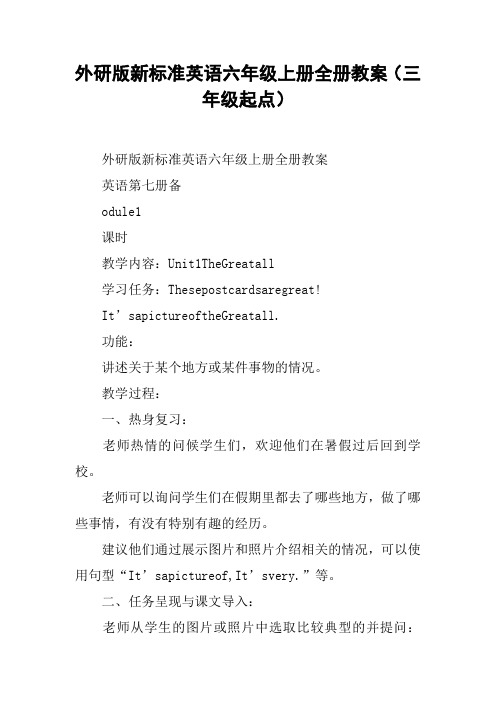
外研版新标准英语六年级上册全册教案(三年级起点)外研版新标准英语六年级上册全册教案英语第七册备odule1课时教学内容:Unit1TheGreatall学习任务:Thesepostcardsaregreat!It’sapictureoftheGreatall.功能:讲述关于某个地方或某件事物的情况。
教学过程:一、热身复习:老师热情的问候学生们,欢迎他们在暑假过后回到学校。
老师可以询问学生们在假期里都去了哪些地方,做了哪些事情,有没有特别有趣的经历。
建议他们通过展示图片和照片介绍相关的情况,可以使用句型“It’sapictureof,It’svery.”等。
二、任务呈现与课文导入:老师从学生的图片或照片中选取比较典型的并提问:“Doyounothisplace?”引导全班学生自由回答。
回答完毕后,老师总结:Thesephotosaregreat.出示长城的明信片,复习单词postcard.老师问:Doyounothisplace?引导学生回答:yes,it’stheGreatall.It’sapictureoftheGreatall.老师再问:Isitlongorshort?It’slong.告诉学生:在这个暑假里,Daing去了美国旅游,并在那里经历了很多有趣的事情。
刚到表哥Sion家,行李还没有收拾好,Daing和Sion就迫不及待的聊开了。
三、课文教学:将本课的挂图贴在黑板上,播放录音,呈现SB活动1,让学生看书,听听Daing和Sion的对话,听完之后,让学生说一说:hoisSion?hereisDaing?hataretheydoing?让学生打开书,放录音,学生边听边看书,勾画出课文中的生词。
教师讲解单词:Postcardorethousandiloetreillionexicocanada再放录音,让学生勾出文中的重要信息,引导学生回答以下问题:明信片上画的是哪里?关于长城、纽约和北京,他们都谈了些什么?讲解课文重点句型:Thesepostcardsaregreat.It’sapictureoftheGreatall.HolongistheGreatall?It’saboutsixthousandsevenhundrediloeters.HobigisBeijing?Ithasgoteightillionpeople.把全班分成两组,表演对话。
新标准英语三年级起点六年级英语上册全册教案

《新标准英语》(三年级起点)第七册教材分析一教材的总体分析本册教材包含十个新授模块和一个复习模块。
每个模块又分为两个单元。
第一单元主要是以课文(对话)的形式呈现本模块所要学习的语言功能与结构。
第二单元则是围绕体现该语言功能与结构的核心句设置的小课文、若干任务型的练习和活动以及歌曲或者歌谣。
本册书的附录有两个单词表,表一是以模块顺序收录的57个四会单词,表二是以字母表顺序收录的115个单词,其中包括第一个单词表中的57个四会和需要三会掌握的48个单词。
此外,本册书还选编了两个课外阅读故事,供教师和学生根据具体教学情况选用,不作统一的教学要求。
二学生分析X Kb1. Co m六年级的学生,对英语学习的强烈好奇心和浓厚的兴趣逐渐被较强的好胜心和集体荣誉感所代替。
我们应该抓住学生心理,尽早帮助他们确立正确的学习态度,养成良好的学习习惯,使他们从被动引导地学到积极主动地学。
经过三年的英语学习学生们掌握了一定的英语语言知识,初步形成了一定的听、说、读、写的能力,有意注意和学习策略也得到了不同程度的发展,但是这也无形中拉开了学生之间的差异。
因此在这一学年段应该更加有意识地进行分层次教学,不只在课堂教学中做到分层次,在作业和评估方面也可以尝试分层次,在各个方面多关注学习有困难的学生,避免差异的进一步扩大,努力做到面向全体。
三总体教学目标依据英语课程标准我们从以下五个方面来确定本册教材的总体教学目标:(一)语言知识目标:要求达到四会的单词57个,即教材第46、47两页单词表中所列的全部单词。
要求达到三会的单词48个,即教材48、49两页单词表中所列非粗黑体的单词)。
学习核心句子38个。
(二)语言技能目标:依据《英语课程标准》四年级的技能目标应高于一级,接近二级要求。
听:能在图片、手势的帮助下,听懂简单的录音材料和小故事;能听懂课堂活动中常用的指令和提问,并做出适当反应。
说:能就所熟悉的个人和家庭等话题进行简短对话;能运用最常用的日常套语;能在教师的帮助下讲述简单的小故事。
Module5Unit2IcanspeakFrench(教案)英语六年级上册

外研社新标准英语三年级起点六年级上册Module 5 Unit 2 I can speak French.教案课时:1课型:阅读写作课一、Teaching aims:Knowledge aims: Ss can read and understand the new words: French, age, story, candy and these sentences: I can speak French. Please be my pen friend!Ability aims: Ss can use the sentence patterns “I can ... ” 复习情态动词can表达能力、请求、意愿和喜好的用法.Emotional aims: Ss are willing to speak English.二、教学重难点:Teaching Key Point: Ss can use the sentence pattern “I can ... ” 复习情态动词can表达能力、请求、意愿和喜好的用法.Teaching Difficult Point: The usage of can.三、Teaching Aids:PPT, Epen.四、Teaching ProcessStep1: Prereading1. Review.Can Daming be Laura’s Chinese pen friend?Can Laura write in Chinese?Can Daming write in English?She wants Daming be her pen friend. They can write in _______.2. Listen, fill and say. A1Sam wants a pen friend. He can write in _______ and _______.Amy wants a ____ _____. She can write in ______.Tom wants a _____ _____.Learn the new word: FrenchThen watch and imitate.Step2 Whilelistening1. Watch and talk.T: They want a pen friend, and they introduce themselves to us. Let’s have a look, how do they introduce themselves? What do they say? Learn the new word: age2. Listen and choose.(1)Where is Mike from?A. He is from Sydney, Australia.B. He is from Hong Kong, China.C. He is from London, UK.(2) What language can Mike speak? (Ability)A. He can speak Chinese.B. He can speak French.C. He can speak English.(3) What does Mike like? (Hobby)A. He likes football, riding, and swimming.B. He likes basketball, swimming and singing.C. He likes football, reading, swimming and singing.Then talk: My name is Mike. I am ______. I am from Sydney, Australia. I can _____ ______. I like _______, ______, ________ and _________.3. Listen and fill.I am Tingting. I am ______. I am ____ _________, _____. I can ____ _____ and ______ __ _______. I like _______ and _______ _____ .4. Listen, read and plete.Learn the new word: story5. Watch and imitate.6. Listen and imitate.Step3 Postreading1. Write and say. A32. Think. Who can be your pen friend? Why?3. Write a letter to your pen friend.Please write a letter to your pen friend.Step 4 Homework1. Listen and imitate the new words and text for three times. 听录音模仿跟读新单词和课文三遍。
- 1、下载文档前请自行甄别文档内容的完整性,平台不提供额外的编辑、内容补充、找答案等附加服务。
- 2、"仅部分预览"的文档,不可在线预览部分如存在完整性等问题,可反馈申请退款(可完整预览的文档不适用该条件!)。
- 3、如文档侵犯您的权益,请联系客服反馈,我们会尽快为您处理(人工客服工作时间:9:00-18:30)。
2013三年级起点六年级上册英语全册教案
(新标准英语)
oudule6unit2I`vegotsoestapsfrochina课型第三课时
导学
目标1.会听、说、读、写本单元的单词:fornife
2.能够听懂而且会说:
1).I`vegotanifeandforandchopstics.
2)I`vegotsoestapsfrochinabutIhaven`tgotanystapsfroc anada.类似句型。
3.会用I`vegot…或I`vegot…butIhaven`tgot句型谈洽个人所拥有的物品等。
4.通过合作学习使学生体验到合作的快乐。
导学
分析学生在已经掌握havegothasgot的基础上
会用I`vegot…或I`vegot…butIhaven`tgot句型谈洽个人所拥有的物品等
重点
难点会运用基本句型谈洽个人所拥有的物品。
导学
媒体录音机、卡片
主体
板书odule6
Unit2I`vegotsoestapsfrochina
I`vegotanifeandforandchopstics.
I`vegotsoestapsfrochinabutIhaven`tgotanystapsfrocan ada.
导案学案二次修注
一、waringup
step1:odules5中的歌曲
“IcanspeaEnglish.”
Step2:Greetings
T:Whoisondutytoday?
二、呈现课文中句型:
step1:完成SB的活动5
Gae:Tabletennis
1)出示活动5的挂图
2)让学生Looandsay
1.师先示范:Forexaple,
“I`vegotaTV.”
2再示范“Ihaven`tgotafootball.”
3)师叫3位同学上台和老师合作说出图中的例句
1.师先说I`vegotaTV
再引导第1位同学说I`vegot
aTVtooAndI`vegotafootball
再引导第2位学生说Ihaven`tgotafootballbutI`vegotabasetball
再引导第3位学生说Ihaven`tgota
basetballbutI`vegotapiano.
4)引导小组合作学习
5)叫一组男生,一组女生上台进行saysentence的比赛 Step2:呈现SB活动2的句型
1)Teacher手拿小刀、叉子、筷子说:Loo,I`vegotanifeandforandchopstics.
利用实物教学单词fornife
2)1.Teacher将手中的小刀、叉子、筷子递到一位同学手里,发问:
Haveyougotanifeandfororchopstics?
2.随机讲解or的用法。
3.师利用学生桌子上的学习用品发问:“Haveyougot…or…
3)师将活动2中的挂图展示在黑板上并给学生讲明√或X的意思。
进一步说明游戏规则。
4)两人一小组合作学习
先让合作,再叫几组轮流表演对话。
Step3:学习SB活动1
LooListenandPoint
1)师给学生说明看活动2的图,活动1的对话内容就是活动2的图
2)出示问题
1、Hasthegirlgotanifeandfororchopstics?
2、Hastheboygotachineseiteorjapaneseite?
3、HasthegirlgotabooaboutAericaorabooaboutchina?
4、Hastheboygotstapsfrochinaorstapsfrocanada?
3)放录音
4)范读对话(2遍)
5)再放录音
Step4:学习SB活动3Listenandrepeat
(1)师放录音
(2)再放录音
Step5:完成AB练习1and2
Ss:Singthesong.
Answerthequestions.
(1)Ss先Looatthepicture
(2)模仿老师说“
“I`vegota…几乎说完所有的图片。
3.模仿老师说“Ihaven`tgotafootball.”几乎说完所有的图片。
Ss:认真Looandlisten明白游戏规则
1、四人一小组Looandsay
2、其余同学判断
(1)跟读fornife
跟读句子
(2)Answerthequestions.
(3)Ss一齐说I`vegota…and…and…”利用桌子上的学习用品进行说话,巩固句型I`vegota…and…and…”I`vegota…butIhaven`tgot”
1.两人一组进行对话练习
2.小组轮流上台表演对话
1.认真听录音
2.跟读对话(2遍)
3.Listenandanswerthequestion
1.先听录音,再说语调
2.打开书边看边听
Doexercise1and2
青铜峡市三小学案导学备课模板
备课人:蒋春艳时间:2013.10.16-
课题六模块的练习课型第四课时
导学
目标通过练习让学生掌握六模块知识点
导学
分析学生在学习六模块两个单元的基础上,巩固掌握六模块知识点
重点
难点不同人称havegot、hasgot的用法导学
媒体录音机、卡片
主体
板书I/we/you/theyhavegot…
He/she/ithasgot…
导案学案二次修注
一、Waringup
1、singasong
2、Greeting
二、presentation
1、教师呈现unit1的重点句型。
三.Practice
1.TeacherguideSstodoexercises.
四.拓展练习
Teacherguideandexplain
五.Suary
六.Hoewor
1、copywordsfiveties
2、Readtext一、Sssingasong
二、分组朗读句型
三、做练习
(一)、补全单词并译成汉语:20% 1、chpstcs2、sn
3、nf
4、f
5、sday
6、pstcrd
7、fr8、frnd
9、snd10、Arca
四、拓展练习:
选词填写,并将代号填入句首括号内:20%
()1、yougotaite?(A、HaveB、Has)
()2、Sheapostcard.(A、havegotB、hasgot)
()3、Ay’sfatherthreebrothers.(A、havegotB、hasgot)
()4、Daing’sotherhasbrothers.(A、aB、two)
()5、Isoechopstics.(A、havegotB、hasgot)
()6、Weflytheitesthepar.(A、inB、on)
()7、Daingyfriend.(A、isB、are)
()8、She’sgoteail.(A、aB、an)
()9、Igotafootball.(A、haven’tB、hasn’t)
()10、chopsticsdifficult.(A、isB、are)
五、指名学生总结本课知识点
六、抄写家庭作业
导学后悟:。
